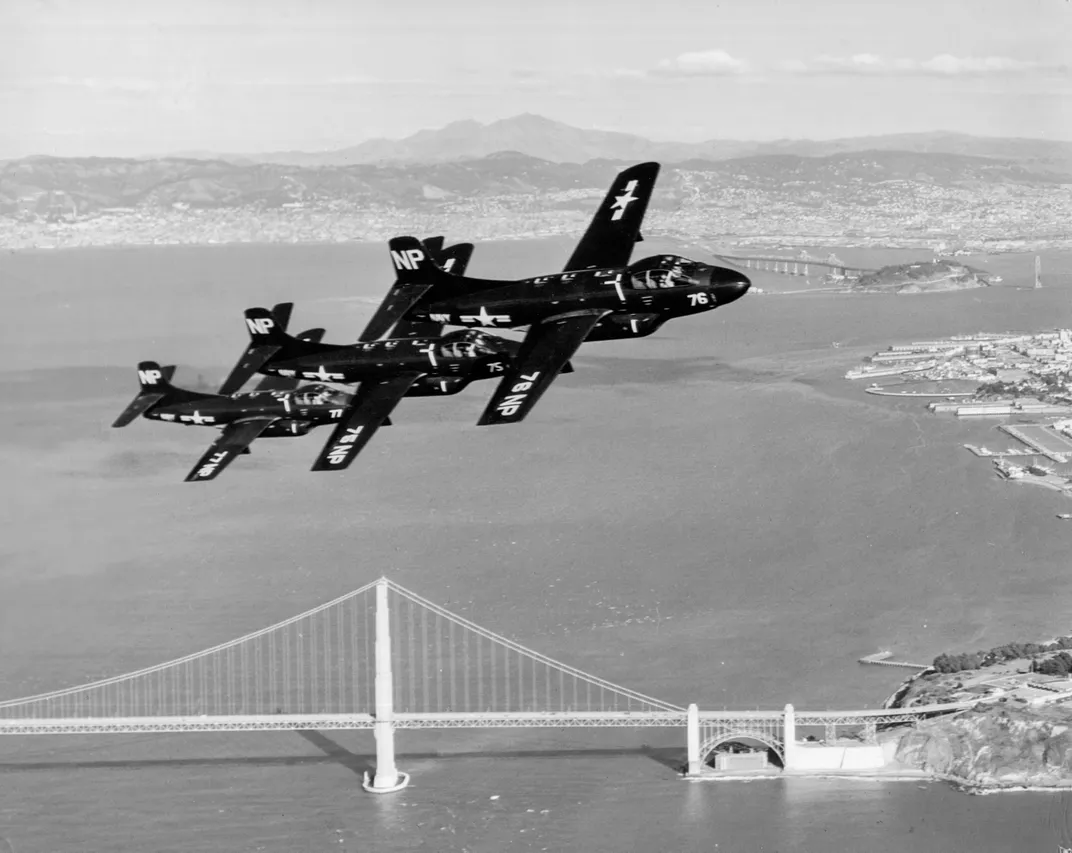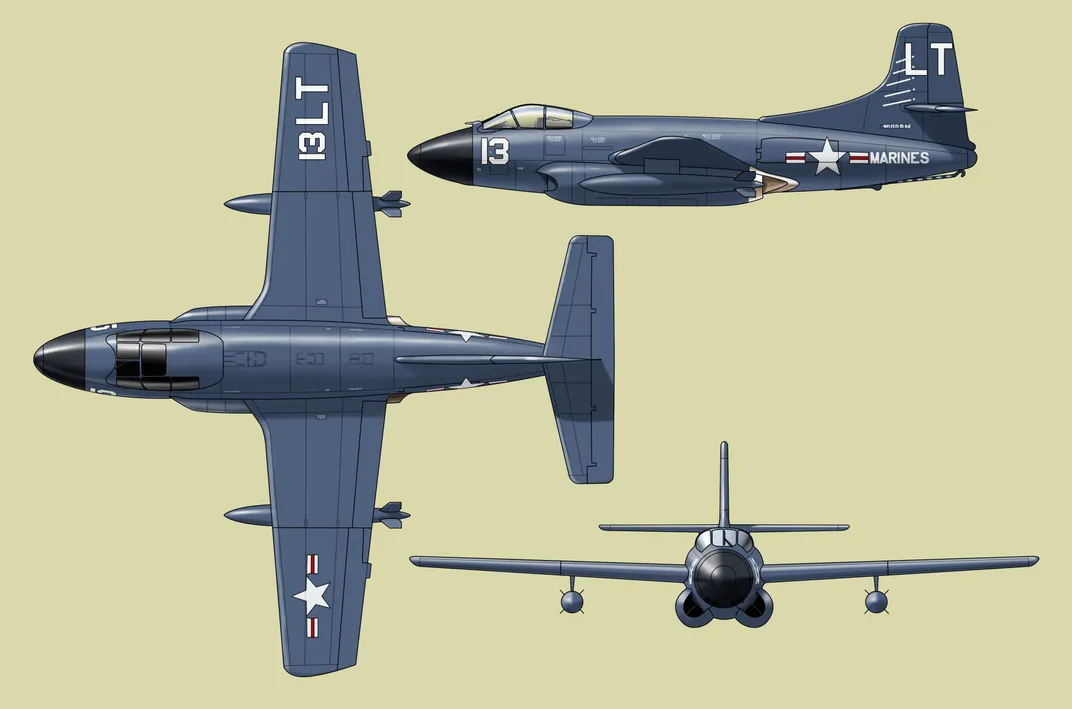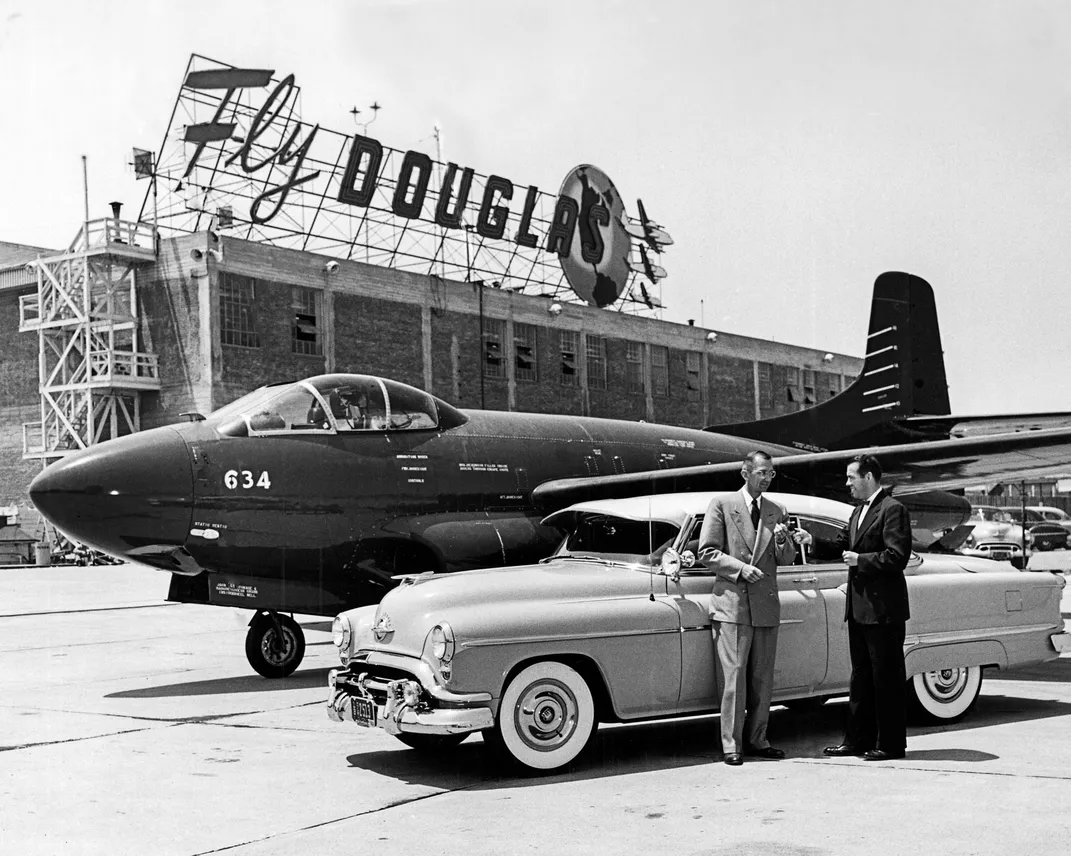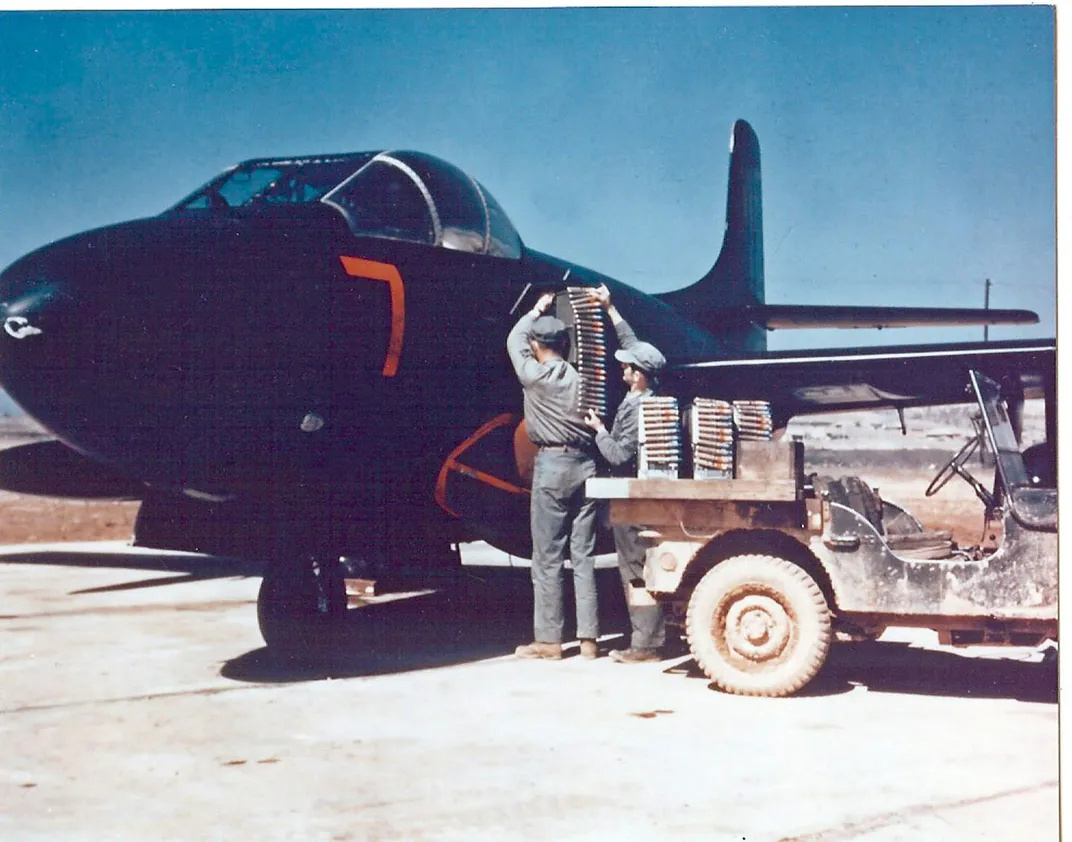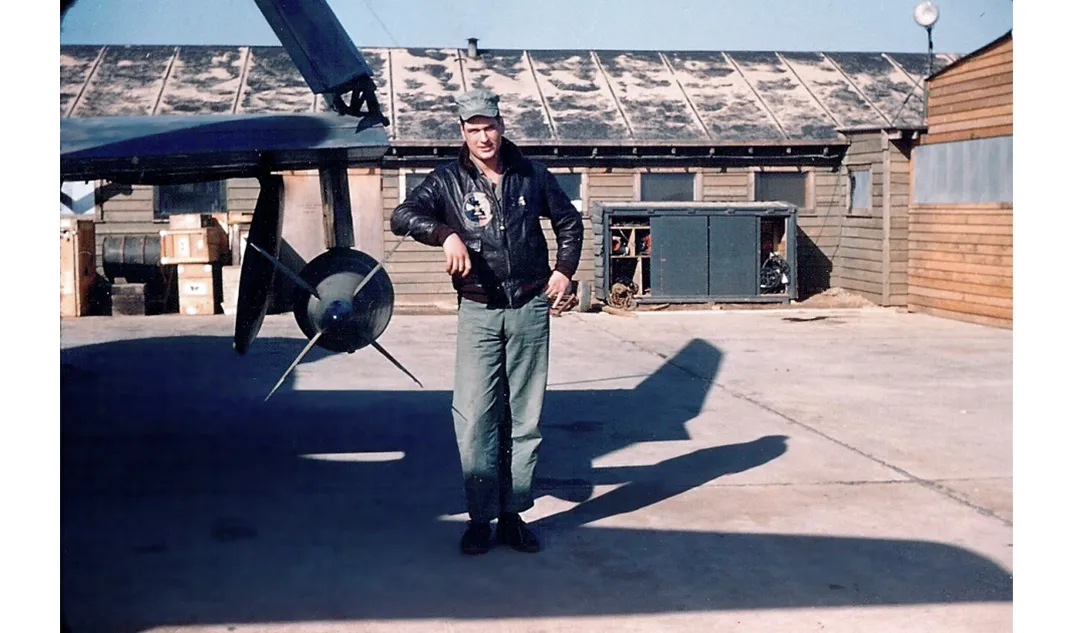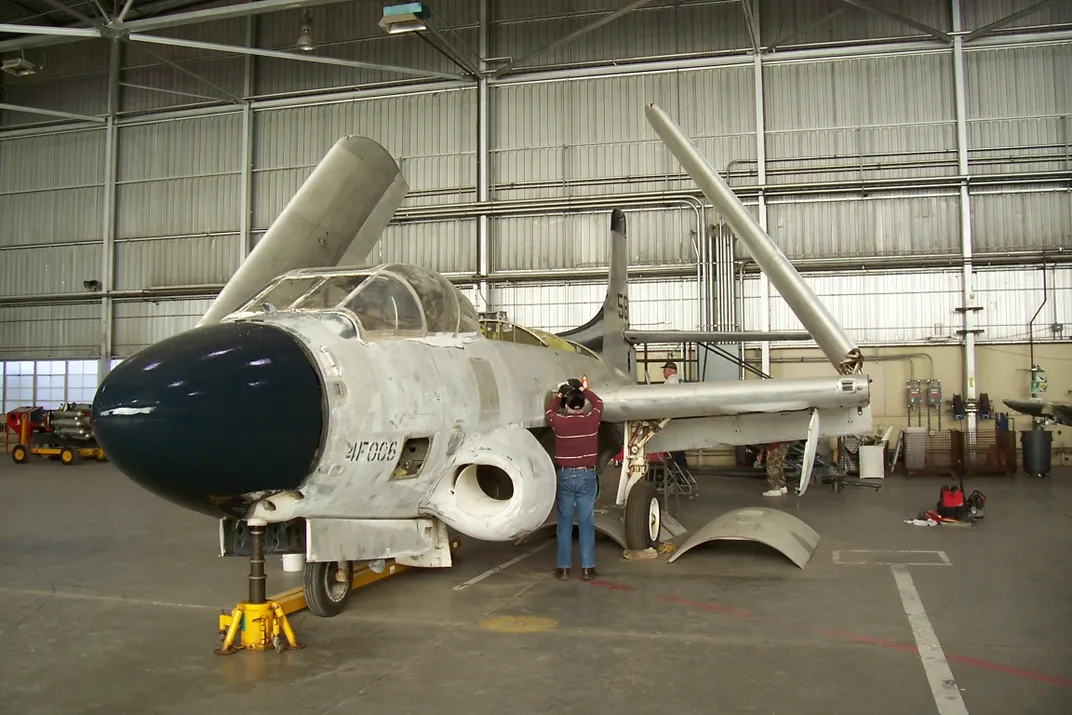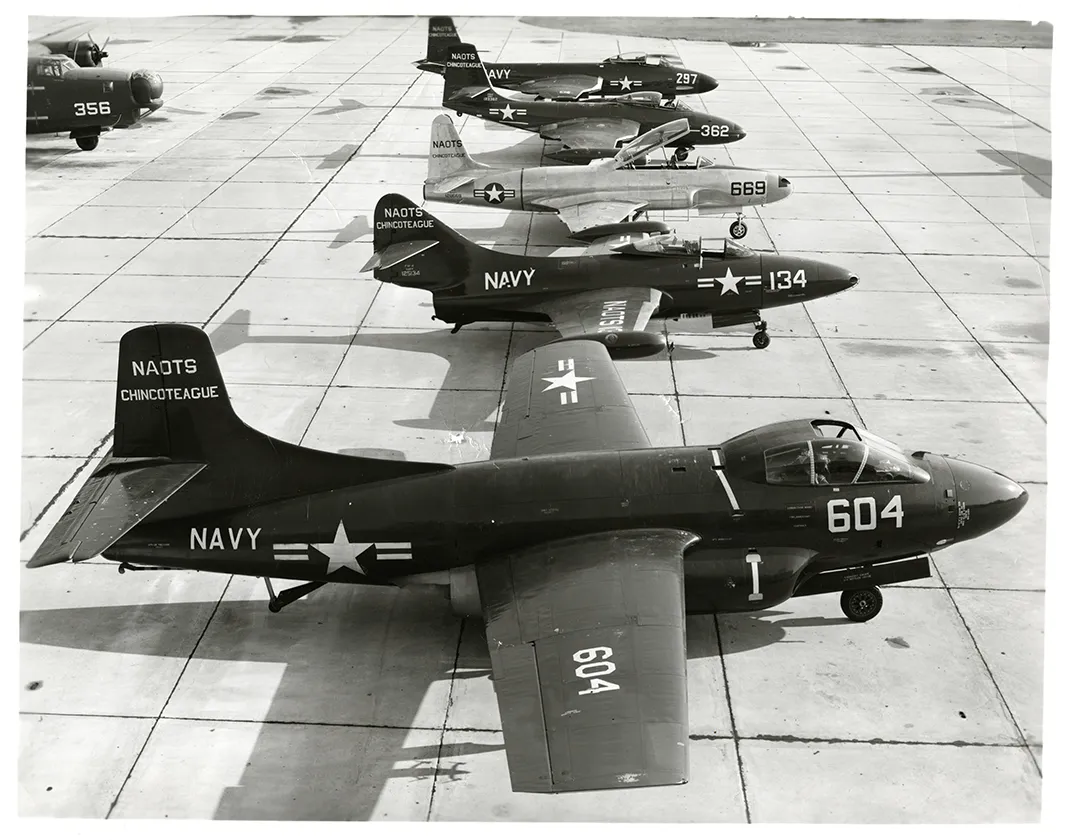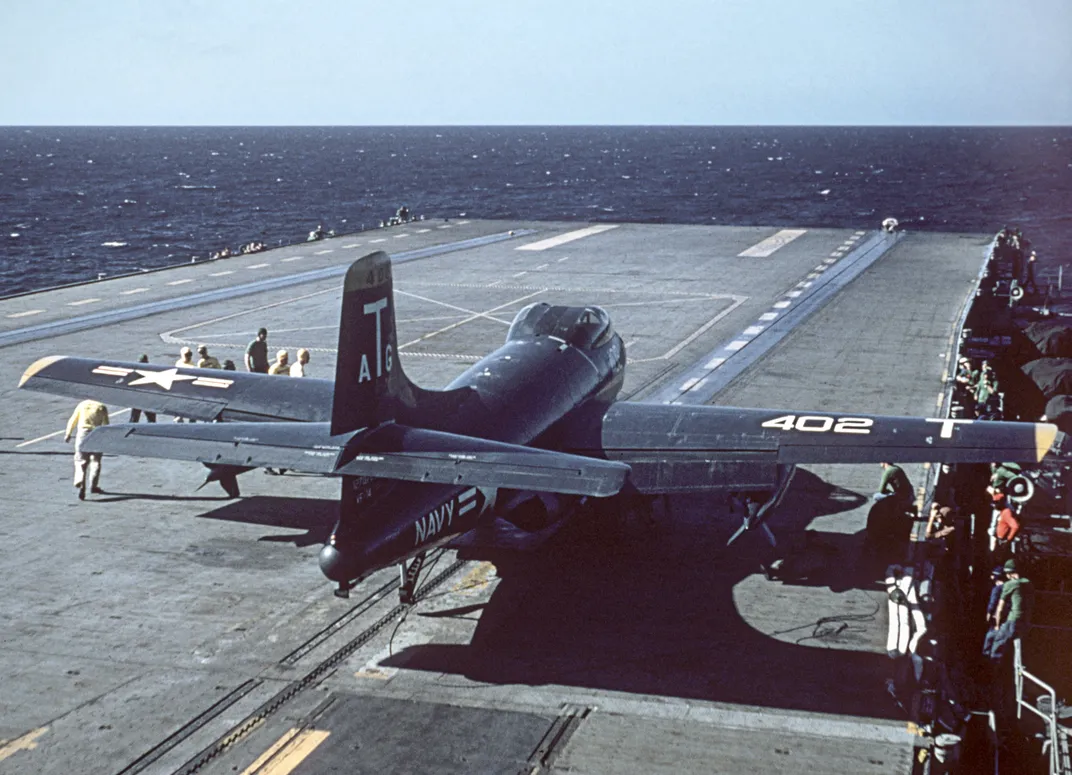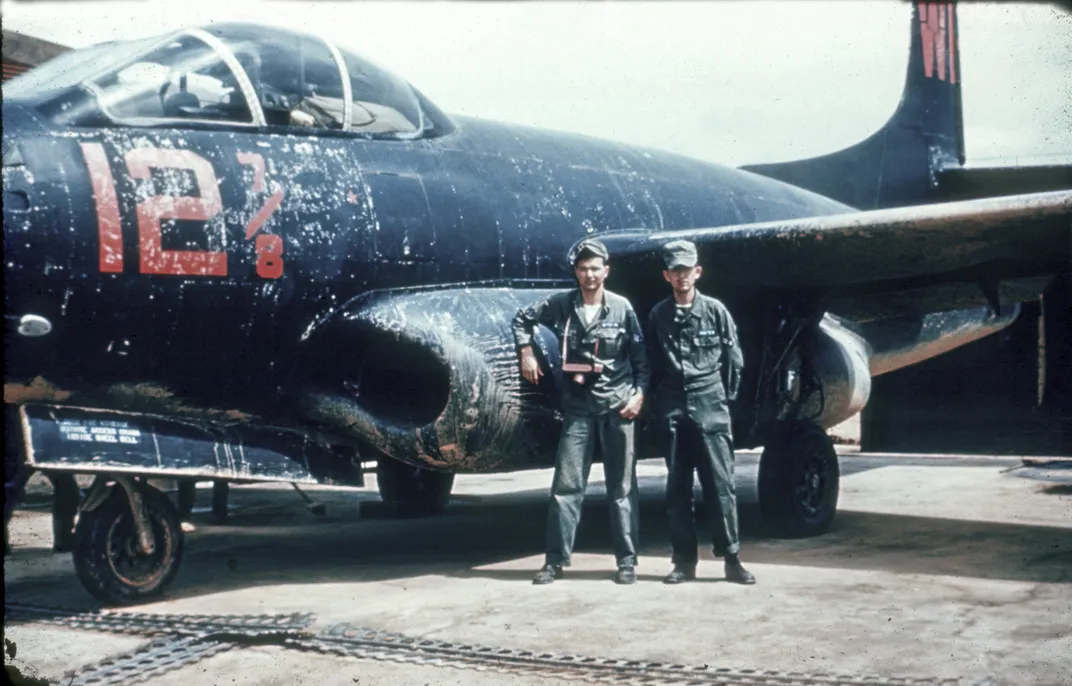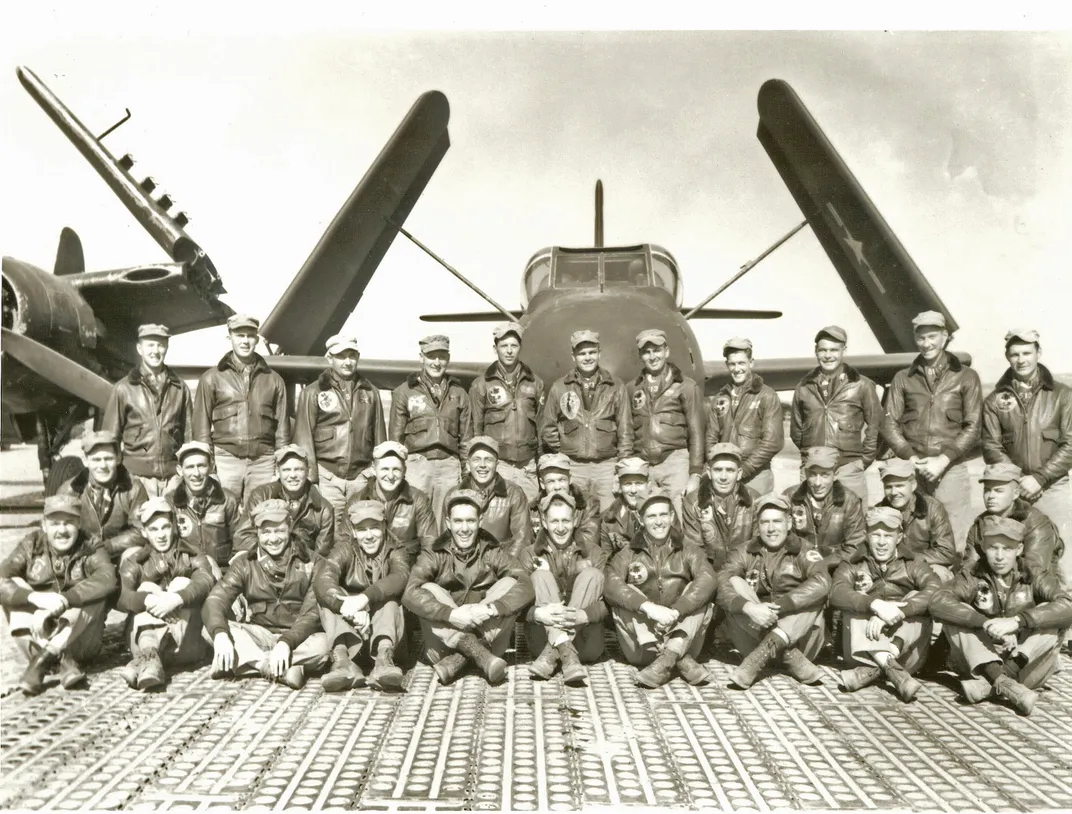The Deadliest Night Fighter in Korea
Why Douglas Skyknight crews weren’t afraid of the dark.
:focal(3764x1045:3765x1046)/https://tf-cmsv2-smithsonianmag-media.s3.amazonaws.com/filer/5b/1a/5b1a8761-3456-47ea-b97b-4ebafc0c6307/05k_jj14_sdasm_01_00019892_live.jpg)
With a profile that would never be considered glamorous, the Douglas Skyknight was a conventional design delivering truly mediocre performance. Still, the Navy needed a sedan, not a sports car, and designer Ed Heinemann, who won fame for the World War II Douglas Dauntless and the 1953 Collier Trophy for the F4D Skyray, gave them what they wanted. Surprisingly, Skyknights would soldier on for two decades of service, easily outlasting speedier, more nimble contemporaries.
Conceived as the Navy’s first purpose-built night fighter, the Douglas F3D was built big to accommodate a complicated radar system along with a powerful battery of four 20-mm cannon. There were three radars: search, fire control, and a novel tail-mounted unit warning of threats approaching from behind. Pilots took off in darkness, flew by instruments, and trusted the radar operators sitting next to them to guide them to enemy aircraft that blipped across scopes mounted on the radar console.
In its attempt to achieve the range that the Navy optimistically specified for the search radar—125 miles—Westinghouse endowed it with an antenna dish 30 inches in diameter—this at a time when most aircraft radar antennas were half that size. Douglas stuffed the thing into a bulbous fiberglass radome. Although the radar never did attain the 125-mile range, it could see a fighter-size target up to 20 miles away, and that made it a valuable weapon system in the Korean War, especially to the bombers set upon by MiG-15s.
When B-29s were sent into North Korea to attack factories, bridges, and dams, their gunners were no match for MiG-15 fighters, which quickly prevented the B-29s from flying daytime missions. Switching to nighttime raids worked until the enemy countered by using a system of ground radar sites to guide MiGs to within visual range of the bombers. After three B-29s were shot down on June 10, 1952, by a dedicated night-fighting team of MiGs, raids were suspended until jet night fighter escorts became available.
That summer, Marine fighter squadron VMF(N)-513 (“N” for “night”) acquired F3D-2s. The squadron was known as the Flying Nightmares. Assigned the dual missions of bomber escort and combat air patrol over United Nations-held territory, the pilots hunted MiG-15s and on November 8 bagged the first one.
Captain Oliver Davis and his radar operator Dramus Fessler were flying at 19,000 feet when a U.S. ground controller radioed from a radar intercept site: enemy aircraft 10 miles straight ahead and nearly 7,000 feet below. Diving at full speed to catch up to the target, the Skyknight crew stalked the bandit with their radar. Davis reported having to apply full power while closing with the enemy, but once within range, he fired into the bright glow of the MiG’s tailpipe, sending the aircraft down in flames. The Flying Nightmares shot down three more MiGs before the end of the war.
Along with North American F-86 Sabres and Lockheed F-94B Starfires, Skyknights were among the few allied aircraft that sought combat with the intimidating MiG-15s during the Korean War. Although no match for the MiG during daylight hours—Skyknight crews were even leery of flying under a full moon—when cloaked by darkness, their radar “eyes” made them killers. Originally assigned to fly B-29 escort missions every other night, taking turns with U.S. Air Force night fighters, the Marines were soon flying nightly, at the insistence of the Air Force general in charge of B-29 operations, who specified F3Ds for the job. The single-seat Sabres were much more effective in daylight; for night intercepts, it appeared that two heads were better than one. And although the Lockheed jet, like the Skyknight, had a second seater, what it didn’t have was the F3D’s radar system—or its firepower. The Starfire had four machine guns; the Skyknight had four cannon.
Orbiting over the B-29 formations as they lumbered to their targets and back, Skyknights deterred MiG attacks and prevented heavy losses. They were almost always flown by Marines from land bases in South Korea. Although qualified for carrier duty in 1951, the airplane had characteristics that discouraged its deployment on flattops in squadron strength. The big twin-jet weighed more than a DC-3; it strained the carrier’s catapult gear. Moreover, carrier ops were a problem for a radar system made up of nearly 300 fragile vacuum tubes.
The airplanes’ low-slung engines were another drawback for operations off the era’s wooden flight deck. They were mounted canted slightly downward in order not to scorch the tail, and when the airplane sat too long waiting to launch, the engines’ exhaust could set fire to the decks. Not an endearing feature with carrier skippers. Although Skyknights weren’t banned from flattops, the Marines, always scheduled to operate the airplane, got a lot more of them—sooner.
Dirty Tricks
The Skyknights became so good at their job that they themselves became hunted. In June 1953, four Navy Skyknights from VC-4 Composite Squadron temporarily detached from the carrier Lake Champlain to join the Marines for nightly patrol and escort duties. One of the Navy pilots, Lieutenant G.G. O’Rourke, recalls in his book Night Fighters over Korea a scheme developed by MiG pilots to trap the F3Ds.
Working in four-aircraft teams guided by ground controllers watching the skies with radar, the enemy would guide one MiG ahead of a Skyknight, where it would be painted by the F3D’s radar. Trailing below and behind the lead MiG-15 would be three more. Once the F3D crew was engrossed in pursuing the first MiG, the trailing MiGs zoom-climbed onto the Skyknight’s tail. MiGs had a phenomenal climb rate, and if the Skyknight crew wasn’t paying attention to the tail radar, the next sound they’d hear would be the shells from a MiG’s cannon hitting their aircraft.
Wrote O’Rourke about MiG tactics: “They had no airborne radars and had to rely completely upon their ground controllers to get them to within visual range behind us, which they did extremely well.” On a coal-black night in July 1953, flying a bomber escort mission over North Korea, O’Rourke was nearly bagged, but for the warning radar in his airplane’s tail. “We went around and around like blindfolded wrestlers,” he wrote, “catching a hint of a target here, then there, then having one spot us for an instant, turning sharply to throw him off.” The MiGs were tenacious; only after they began to run low on fuel did they break off.
O’Rourke is certain that the July 2, 1953 loss of a Skyknight piloted by Lieutenant Bob Bick was due to the same trap. Bick reported firing on a target ahead, then sent a terse final radio message: “Taken a couple of 37s.” (MiGs fired 37-mm cannon rounds.)
Jet v. Biplane
Eugene “Mule” Holmberg was a young Marine staff sergeant in 1953 when he was posted to VMF(N)-513 as a Skyknight radar operator. Holmberg immediately liked the big jet. Its roomy cockpit accommodated his sizable frame, and its Westinghouse AN/APQ-35 radar was the most formidable airborne radar system of the day. “I loved it, just a super plane for a night fighter,” he says. “Our planes had a track-while-scan capability that no one else had at the time.” The Skyknight’s radar system could lock on to a target and continue to search ahead for other threats.
One difficult threat to deal with was the nocturnal raids by Polikarpov PO-2s. The tiny wood-and-fabric biplanes were surprisingly destructive. Flying low and slow and at night, the Bedcheck Charlies, as they were called, were difficult to find, let alone shoot down.
The Polikarpovs were extraordinarily unsophisticated warplanes. Holmberg recalls that the backseater carried a submachine gun and that both pilot and backseater tossed mortar shells freehand over the side. “One dropped on a U.S. ammo dump, causing explosions and fires for three days,” says Holmberg. And Holmberg vividly remembers trying to down one of the elusive raiders. With the Skyknight’s radar, he had no trouble tracking the tiny biplane flying behind U.N. lines.
There were other complications. With the fighter’s radar locking on, Holmberg’s Marine pilot would make several runs at the PO-2, but despite clearance to do so, he refused to fire, fearing that the airplane’s 20-mm cannon would hit friendlies below. No one else observed such restraint, says Holmberg. The “friendly” troops below, spooked by multiple passes of a low-flying jet, began shooting into the night sky, and Holmberg saw muzzle flashes from the enemies’ return fire as they swept by on their ninth and final run, nearly colliding with the biplane.
“The pilot just wouldn’t pull the trigger,” says Holmberg, still annoyed after all these years. “Back at the base, I got out and threw my helmet to the ground in frustration.”
As frustrating as Holmberg’s experience was, it could have been worse. An Air Force F-94B Starfire crew trying to intercept a slow-flying PO-2 fatally collided with it on the third pass one February night in 1952.
Although not much was expected from the clumsy Skyknights, they achieved an air combat first on December 10, 1952, when Lieutenant Joseph Corvi and radar operator Master Sergeant Dan George knocked down a low-flying PO-2 sight unseen: Only the Skyknight’s radar aimed their guns. At war’s end, Skyknights had six confirmed and two probable kills—more than any other jet night fighter.
The Whale
Ed Heinemann’s team knew how to build fast airplanes; in 1947 their slender, jet-powered Skystreak X-plane set a world speed record: 650 mph, with Marine ace Major Marion Carl at the controls. But even Heinemann was intimidated by the Navy’s specifications for the F3D: “High speed requirements seemed completely incompatible with those calling for a two-place cockpit and a large space forward for the radar package,” he wrote in his autobiography, Combat Aircraft Designer.
Since the outsize radar dish determined the fuselage size, the designers were able to create a spacious cockpit—with the requested side-by-side seating—without adding drag penalties. It wasn’t pretty, but that commodious nose was one of the reasons the Skyknight lasted as long as it did: At irregular intervals, the Navy exchanged electronics and missions. The longer the F3D flew, however, the more its sluggishness contrasted with the capabilities of contemporary combat aircraft and the more apt its nickname seemed: “Willy the Whale” or, to those who flew them, simply “Whale.”
Although the development of the straight-wing fighter had been relatively problem free—an XF3D-1 prototype first flew in March 1948—the first 28 F3D-1s were powered by puny Westinghouse J34 turbojets; each produced 3,250 pounds of thrust. Heinemann believed the more powerful J46 engines slated for the F3D-2 version would greatly improve performance, but the engine didn’t make it into F3Ds. Instead the dash 2s were fit with uprated J34s that provided a measly 3,400 pounds of thrust. “My vacuum cleaner had more power,” says Jerry Mitchell. A retired Marine colonel, Mitchell flew Skyknights on reconnaissance missions in the mid-1960s. “It was a fun, comfortable old airplane,” he says. “But I’d hate to fly combat with it.”
The frugal Marines had transformed 35 of the obsolescent Korean War fighters into the first Marine tactical jets specialized for electronic warfare. Able to pack lots of black boxes into the Skyknights’ snouts, the Marines used them during the tense days of the Cuban missile crisis to monitor Soviet air defense radars deployed on the island. On the heels of that success, the aircraft continued as electronic warfare platforms during the cold war; in 1962, they received the designation EF-10B.
The Whale was given high-octane avgas instead of jet fuel to get the maximum power out of its feeble engines. Wayne “Flash” Whitten, who flew 175 Skyknight missions as an electronic countermeasures officer, or ECMO, during the Vietnam War, first met the airplane as a lowly Marine second lieutenant. Whitten was just starting out flying right seat on the Whale, and one of his jobs on Stateside cross-country flights was to make sure the airplane was fueled properly. “The Air Force just wasn’t accustomed to pouring avgas into a jet,” he recalls. “I loved the old plane because it had personality. It had a roomy cockpit, ashtrays…even a cigarette lighter.”
Jammers
Early in the Vietnam War, Marine EF-10Bs were among the few assets able to locate and jam the radars of enemy surface-to-air missiles and anti-aircraft guns. That capability got them a lot of work supporting Air Force and Navy strikes into North Vietnam. “They wouldn’t launch [strike teams] if we didn’t have support up there,” says Marine General Jack Dailey, a former EF-10B pilot who is today the director of the Smithsonian Institution’s National Air and Space Museum.
While supporting a strike package of Air Force F-105s into North Vietnam on March 18, 1966, Whitten saw the fireball of an exploding enemy missile engulf his wingman. Aboard the stricken EF-10B Skyknight were VMCJ-1 squadron mates. “In a flash of eye—gone,” he remembers. No chutes were seen.
Shortly after that loss, radar-controlled anti-aircraft guns began tracking Whitten’s Whale.
Mule Holmberg was flying as backseater in an escorting Marine F-4 Phantom II that day. He radioed Whitten a warning: “Flak bursts coming up your six!” The Whale’s pilot broke hard as Whitten quickly got a “jammer” on the gun’s radar. “Mule saved our butts,” Whitten says.
“That was the only airplane I’ve ever flown where I added full power, took my feet off the brakes, and it just sat there, trying to decide whether it would fly that day,” says Dailey. “The temperatures on the runway at Da Nang used to get up to 125 degrees, and I’ve rolled 9,500 feet on a 10,000-foot runway and still only be doing 90 knots. It would fly at 90.”
Doug Bodkin also flew EF-10Bs for the Marines out of Da Nang, and although he took a perverse pleasure in piloting something nearly as old as he was, he was mindful of its sluggish takeoff. The takeoff rolls were long enough to give “one ample opportunity to ponder the lack of ejection seats during that event,” he says.
To reduce complexity and to limit the weight of an already underpowered airplane, Heinemann’s team left out ejection seats and substituted an unusual escape slide system. It was a simple chute that began behind the seats and slanted down to a belly exit between the engines, allowing, at least in theory, for a high-speed bailout.
“In the hangar at Da Nang, we’d put an airplane up on jacks and put mattresses underneath to train to use that chute,” says Dailey. “When you get ready to go, there’s a handle that you pull, and a trap door flies open, and a panel on the bottom of the airplane falls off, and the pilot’s seat literally falls apart.” The ECMO was to exit first, grabbing a bar above the escape chute and swinging his legs out. The pilot then uses the same bar to vault down.
“We used to try to jump on the ECMO,” Dailey says. “If he loitered on that mattress, he was going to get stomped on by the pilot.”
Jerry Dixon recalls an exercise he flew during which raiders—recon Marines—found an unexpected use for the Skyknight’s escape chute. He was deployed to the Philippines for the exercise in February 1958. Assigned the role of aggressor squadron for the maneuvers, Marine planners used Whales for a clandestine insertion of Marine commandos behind “enemy” lines. Dixon was part of a flight of four Skyknights that flew night formation with a recon Marine occupying the right seat of each airplane.
Approaching the drop zone, the raiders got out of their seats and slid into each airplane’s escape chute, keeping their heads still in the cockpit. “When we got to the drop zone, the formation leader made the prearranged signal to drop, I tapped my raider on the head, and he was gone like a shot,” says Dixon, still in awe after all these years. “You talk about a set of balls to do what those guys did.” Dixon later heard that two of the commandos broke bones landing in the jungle.
The year before, Dixon and his radar operator, Richard Long, had flown another unusual mission in a Whale. Because of its size and stability, the F3D was instrumental in developing the Sparrow family of air-to-air guided missiles; Dixon and Long scored their first “kill” by bagging an F6F target drone with a Sparrow 1 fired from an F3D-2M missile ship. Thereafter, as members of VMF(AW)-513 (“AW” for “all weather”), based at Atsugi, Japan, they stood nightly alert, launching in response to Soviet aircraft probing area defenses.
Twilight
When the Skyknights were displaced by a new generation of all-weather fighters in the 1950s, many were reconfigured as trainers. Mike Glenn was an aviation machinist mate assigned to fighter training squadron VF-121 at Naval Air Station Miramar, working with F3D-2T2s. Painted in the standard Navy training command colors, white and bright orange, the aircraft had the F3H Demon’s radar in the nose and were used to train Demon pilots on radar intercept procedures.
Today Glenn is leading a restoration at the Air Force Flight Test Center Museum at Edwards Air Force Base, California. The museum collects aircraft that made their first flights at Edwards. “So now, after 50 years working around planes, I have gone back full circle to the F3D airplane of 1960,” says Glenn. “Wonder if I can recover the rest of my youth?”
Tired old Whales were gradually replaced by vastly more capable EA-6A Intruders, and in October 1969 flew their last combat missions. The Marines, known for an appreciation of history and ceremony, selected Oliver Davis, then a colonel, to fly the last official Skyknight mission in May 1970. It had been Davis who, back in 1952, was the first Skyknight pilot to shoot down a MiG-15.
Only 268 Skyknights of all types were built—the last was delivered in 1952—but the Whale just wouldn’t fade away. It became the Forrest Gump for naval air, out of the limelight but present at the creation of many technologies over two decades. And the old warrior’s tour of duty isn’t quite over. In Lakewood, California’s Del Valle Park, a Skyknight that once entertained a generation of kids as a playground attraction now serves as a dedicated war memorial.
